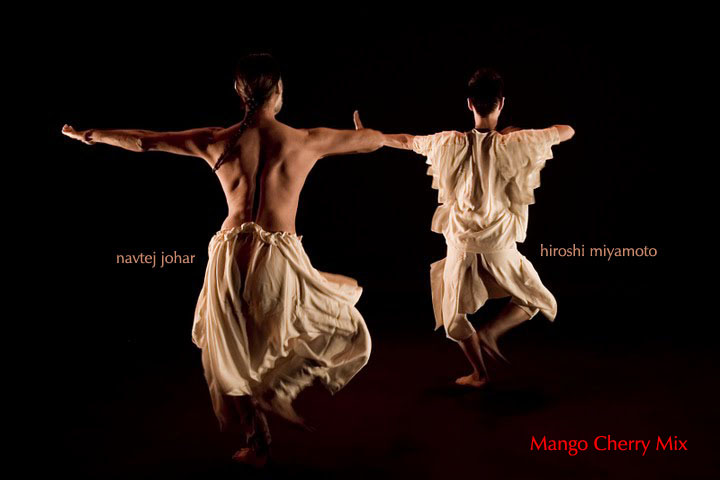Poignant
duets give the work its soul
PAULA
CITRON
Globe
and Mail, Toronto, Sunday, Aug. 15, 2010

Photo:
Amar Khoday
In
a narrow band of light, two dancers approach each other from the sides of the
stage. From the start, they express their cultural differences.
Navtej
Johar represents the Mango. With a raised knee, then a heel slapping the floor,
followed by the toes, Johar performs the bharatanatyam walk from southern India.
Hiroshi
Miyamoto represents the cherry blossom. His shoulders hunched, arms hanging limply
at this side, he moves in a flat-footed, slow shuffle – the walk from traditional
Japanese nihon buyo.
Are
they lovers? Father and son? Teacher and student? Leader and follower? In the
cleverly titled Mango Cherry Mix, Johar and Miyamoto explore the cultural
experiences that bring them together and keep them apart.
These
excellent dancers have a strong presence whether moving as one or as individuals.
What emerges is a search for sunya (India) or Zen (Japan) – the journey at the
heart of their diverse spiritualities.
The
mango
Trim
but commanding, Johar radiates charisma and dominates the work. His controlled
bharatanatyam training yields a crisp attack – with pounding footwork, he cuts
through the space with the precision of a surgeon’s knife.
But
he also exhibits consummate grace. His delicate, filigreed gestures rivet the
eye with their clarity. A key solo helps define the work because it takes Johar
back to his dance roots. He launches into bharatanatyam storytelling, replete
with expressive eyes and face, gorgeous body lunges, and nimble arms and fingers
that enact the mime.
Rather
than enacting sacred Hindu texts, he tells the story of the relationship between
him and Miyamoto. It radiates warmth and gentle humour.
The
cherry blossom
With
a supple body that allows for fluid movement, Miyamoto is an engaging dancer.
But throughout Mango Cherry Mix, he seems to defer to Johar.
While
Johar seems to know where he is in life, Miyamoto is clearly in a search pattern
throughout the piece. It takes him several false starts before he can enter a
square of light. First, he twists his body so that the sole of one foot is lit,
and then, like a contortionist, he allows other parts of his body to enter the
square. When he is within it, he is a shut-down, huddled mass.
But
Miyamoto is a lyrical mover, a result of his many-layered training. His ballet
turns, jumps and leg extensions exhibit a light touch; equally, his bharatanatyam
has none of the fierceness – he moves with a youthful freedom.
The
mix
The
music reflects both the insider and the outsider that these men are – the South
Asian and Japanese recordings reflect their homelands, while the dissonance of
modern music represents their collisions with Western culture.
One
deliciously satiric segment, performed to the Handel aria Let the Bright Seraphim,
can be seen as the revenge of the outsider as the two of them make fun of ballet.
Johar runs in tiny little steps as if on point, his arms like giant wings, while
Miyamoto executes the twirls and arabesques with proper port de bras.
There
are beautiful moments in which the two dance together in synchronized patterns,
shoulders touching, bodies moving as one – these poignant duets give the work
its soul.
And
the final moment is glorious in its diversity. The two stand together, Johar stoic,
still and expressionless while Miyamoto’s hand is to his heart. His final image
is a clutched fist of ecstasy as his eyes slowly close.
While Mango Cherry Mix expresses emotional loss, Johar and Miyamoto have also
found an experience they can share. The moment of sunya and Zen is within their
grasp.
Mango
Cherry Mix performed by Navtej Johar and Hiroshi Miyamoto, presented by InDance,
at the Winchester Street Theatre, in Toronto on Aug. 14 & 15, 2010
|
![]()
![]()